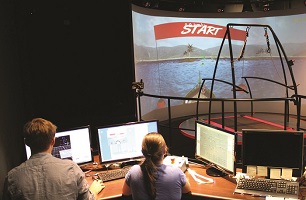Rehabilitation Virtual Reality Lab Projects
Research
 Dynamic Stability Assessment within Rehabilitation Virtual Reality Environments for Improved Mobility: This study investigated how able-bodied individuals and individuals with a transtibial or transfemoral amputation maintained stable gait when walking over a variety of stability-challenging terrain. The CAREN-Extended virtual reality system provided a controlled environment for participants to perform walking tasks, including incline/decline, cross-slopes, and simulated uneven walking conditions.
Dynamic Stability Assessment within Rehabilitation Virtual Reality Environments for Improved Mobility: This study investigated how able-bodied individuals and individuals with a transtibial or transfemoral amputation maintained stable gait when walking over a variety of stability-challenging terrain. The CAREN-Extended virtual reality system provided a controlled environment for participants to perform walking tasks, including incline/decline, cross-slopes, and simulated uneven walking conditions.
 An investigation of the role of optic flow in gait biomechanics in the Computer Assisted Rehabilitation Environment (CAREN), and a CAREN based intervention to improve slope walking following lower limb amputation (LLA): This study found that there are no detrimental effects of CAREN exposure, and the presence of optic flow does not affect gait biomechanics in and of itself. CAREN can be used safely for physical rehabilitation. Slope walking therapy protocols will likely lead to significant improvements in gait biomechanics and increased confidence in Canadian Armed Forces members with LLA.
An investigation of the role of optic flow in gait biomechanics in the Computer Assisted Rehabilitation Environment (CAREN), and a CAREN based intervention to improve slope walking following lower limb amputation (LLA): This study found that there are no detrimental effects of CAREN exposure, and the presence of optic flow does not affect gait biomechanics in and of itself. CAREN can be used safely for physical rehabilitation. Slope walking therapy protocols will likely lead to significant improvements in gait biomechanics and increased confidence in Canadian Armed Forces members with LLA.
2D04: Thompson, A. A., PhD, Sinitski, E., MSc, Godsell, P., Capt, BSc, Wilken, J., PhD, Besemann, M., LCol, MD, Honey, J. M., Lt(N) The 5th Annual Military and Veteran and Health Research Forum, MVHR Forum 2014 Abstracts, page 38.
Application Developments
Static Balance Training (Paddleboarding or Surfing)
Originally created for a patient that was hoping to practice their balance in preparation for paddleboarding in the community – the static balance training application allows patients with balance impairments an opportunity to practice balance reactions, such as ankle, hip and stepping strategies with varying levels of perturbation difficulty. Visually, the user can see their ‘paddleboard’ that floats on waves, and the platform moves with the movement of the waves, but also moves based on the user’s movements as well. Like a regular paddle board, if the user looser their balance in one particular direction, the board (or in this case the platform) will move in the same direction, magnifying their sway.
Cognitive Dual Task, Situational Awareness
As an added dimension to most of our balance and gait applications, visual distractions and cognitive tasks have been included that allows clinicians to layer complexity to the user’s activities. Some of these additions include visual changes to the environment (ie: light vs. dark, or thunderstorm), some include scanning the environment for either an object or a sign, and further still, sometimes the user must respond to the sign that they spot (ie: read the word, or answer a math question).
Past Initiatives
 2012 English
,
2012 French
2012 English
,
2012 French
